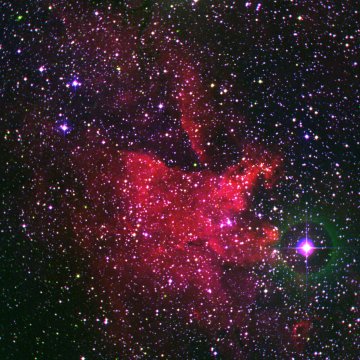RCW 173
Also called
Sh 2-60, LBN 82, W 42Coordinates: (25.3°, 0.21°)
[ Catalog | Explorer | SIMBAD ]
It may be associated with the radio source W 42.
It is visible in infrared as the prominent bubble [CPA2006] N37 and appears to be ionised by an obscured O7 II giant.
The radio source W 42 has wildly varying distance estimates (from 13400 parsecs to 2200 parsecs). If the near estimate of 2200 parsecs (which is from a recent paper published in 2000) is accepted, then W 42 is likely part of the Sh 2-60 nebula. Infrared imagery in the same paper shows that W 42 is energised by a massive, dense and young OB star cluster embedded in an obscuring dust cloud in the bottom left part of this image.
The average distance to the stars in this nebula is 2000 parsecs. [2]
The distance to W 42 is only 2200 parsecs.[3]
This is W 42.[4]
Likely ionised by an O7 II giant. [5]
The distant (14500 parsecs) radio source GAL 025.52+00.22, is also in this field and is believed to house a Luminous Blue Variable similar to Eta Carinae.[6]
Notes
1. ^ Lester, D. F., Dinerstein, H. L., Werner, M. W., et al. (1985). "Star formation in the inner Galaxy - A far-infrared and radio study of two H II regions", The Astrophysical Journal, Vol. 296, 565-575. [1985ApJ...296..565L]
2. ^ Lahulla, J. F. (1985). "UBVRI photometry of stars in several H II regions", Astronomy and Astrophysics Supplement Series, Vol. 61, 537-545. [1985A&AS...61..537L]
3. ^ Blum, R. D., Conti, P. S., & Damineli, A. (2000). "The Stellar Content of Obscured Galactic Giant H II Regions. II. W42", The Astronomical Journal, Vol. 119, 1860-1871. [2000AJ....119.1860B]
4. ^ Woodward, C. E., Pipher, J. L., Helfer, H. L., et al. (1989). "G25.4-0.2S - A Possible OB Cluster in the Inner Spiral Arm", Bulletin of the American Astronomical Society, Vol. 21, 1155. [1989BAAS...21.1155W]
5. ^ Marco, A. & Negueruela, I. (2011). "An obscured cluster associated with the H II region RCW173", Astronomy and Astrophysics, Vol. 534, A114. [2011A&A...534A.114M]
6. ^ Clark, J. Simon, Steele, Iain A., & Langer, Norbert (2000). "Discovery of a Bipolar Shell around G25.5+0.2", The Astrophysical Journal, Vol. 541, L67-L70. [2000ApJ...541L..67C]
Distance estimates
2200 pc [2003A&A...397..133R]3440 pc +/- 950 [1984ApJ...279..125F]
2070 pc +/- 100 [1984NInfo..56...59A]
3000 pc [2011A&A...534A.114M]
Links
[ DSS | ADS | ADS Abstract ]
map | book | blog | gallery | sources

This image was created using the POSS-II/UKSTU data of the Digitized Sky Survey and SuperCOSMOS using the process described here.
According to my correspondence with the Royal Observatory Edinburgh and the Space Telescope Science Institute, I am allowed to use the POSS-II/UKSTU data to create and display images for non-commercial purposes so long as I include this fine print for the SuperCOSMOS data:
Use of these images is courtesy of the UK Schmidt Telescope (copyright in which is owned by the Particle Physics and Astronomy Research Council of the UK and the Anglo-Australian Telescope Board) and the Southern Sky Survey as created by the SuperCOSMOS measuring machine and are reproduced here with permission from the Royal Observatory Edinburgh.
and this acknowledgement taken from the DSS site:
The Digitized Sky Surveys were produced at the Space Telescope Science Institute under U.S. Government grant NAG W-2166. The images of these surveys are based on photographic data obtained using the Oschin Schmidt Telescope on Palomar Mountain and the UK Schmidt Telescope. The plates were processed into the present compressed digital form with the permission of these institutions.
The Second Palomar Observatory Sky Survey (POSS-II) was made by the California Institute of Technology with funds from the National Science Foundation, the National Geographic Society, the Sloan Foundation, the Samuel Oschin Foundation, and the Eastman Kodak Corporation.
The UK Schmidt Telescope was operated by the Royal Observatory Edinburgh, with funding from the UK Science and Engineering Research Council (later the UK Particle Physics and Astronomy Research Council), until 1988 June, and thereafter by the Anglo-Australian Observatory. The blue plates of the southern Sky Atlas and its Equatorial Extension (together known as the SERC-J), as well as the Equatorial Red (ER), and the Second Epoch [red] Survey (SES) were all taken with the UK Schmidt.
The "Second Epoch Survey" of the southern sky was made by the Anglo-Australian Observatory (AAO) with the UK Schmidt Telescope. Plates from this survey have been digitized and compressed by the ST ScI. The digitized images are copyright ? 1993-5 by the Anglo-Australian Observatory Board, and are distributed herein by agreement.
The "Equatorial Red Atlas" of the southern sky was made with the UK Schmidt Telescope. Plates from this survey have been digitized and compressed by the ST ScI. The digitized images are copyright ? 1992-5, jointly by the UK SERC/PPARC (Particle Physics and Astronomy Research Council, formerly Science and Engineering Research Council) and the Anglo-Australian Telescope Board, and are distributed herein by agreement.
The compressed files of the "Palomar Observatory - Space Telescope Science Institute Digital Sky Survey" of the northern sky, based on scans of the Second Palomar Sky Survey are copyright ? 1993-1995 by the California Institute of Technology and are distributed herein by agreement. The compressed files of the "Palomar Observatory - Space Telescope Science Institute Digital Sky Survey" of the northern sky, based on scans of the Second Palomar Sky Survey are copyright ? 1993-1995 by the California Institute of Technology and are distributed herein by agreement.